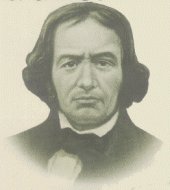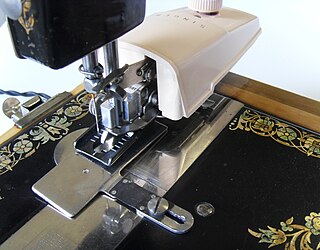Related Research Articles

Singer Corporation is an American manufacturer of consumer sewing machines, first established as I. M. Singer & Co. in 1851 by Isaac M. Singer with New York lawyer Edward C. Clark. Best known for its sewing machines, it was renamed Singer Manufacturing Company in 1865, then the Singer Company in 1963. It is based in La Vergne, Tennessee, near Nashville. Its first large factory for mass production was built in 1863 in Elizabeth, New Jersey.
This timeline of clothing and textiles technology covers the events of fiber and flexible woven material worn on the body; including making, modification, usage, and knowledge of tools, machines, techniques, crafts, and manufacturing systems (technology).

A sewing machine is a machine used to sew fabric and materials together with thread. Sewing machines were invented during the first Industrial Revolution to decrease the amount of manual sewing work performed in clothing companies. Since the invention of the first sewing machine, generally considered to have been the work of Englishman Thomas Saint in 1790, the sewing machine has greatly improved the efficiency and productivity of the clothing industry.

A lockstitch is the most common mechanical stitch made by a sewing machine. The term "single needle stitching", often found on dress shirt labels, refers to lockstitch.

Elias Howe Jr. was an American inventor best known for his creation of the modern lockstitch sewing machine.

James Edward Allen Gibbs (1829–1902) was a farmer, inventor, and businessman from Rockbridge County in the Shenandoah Valley in Virginia. On June 2, 1857, he was awarded a patent for the first twisted chain-stitch single-thread sewing machine using a rotating hook. In partnership with James Willcox, Gibbs became a principal in the Willcox & Gibbs Sewing Machine Company. Willcox & Gibbs commercial sewing machines are still made and used in the 21st century.

Barthélemy Thimonnier was a French inventor, who is attributed with the invention of the first sewing machine that replicated sewing by hand. He was born in L'Arbresle, in Rhône in France.

Walter Hunt was an American mechanical engineer. Through the course of his work he became known for being a prolific inventor. He got first involved with mechanical innovations in a linseed producing community in New York state that had flax mills. While in New York City to promote his inventions, one thing led to another and he got involved in inventing the streetcar gong that is used throughout the United States. This then led him to invent other useful items like the safety pin, sewing machine, repeating rifle, and fountain pen. About two dozen of his inventions are used today in basically the same form as he had patented it. In spite of his many useful innovative creations he never became wealthy since he sold off most of his patent rights to others at low prices with no future royalties. Others made millions of dollars from his devices, one in particular was the safety pin.

Allen Benjamin Wilson (1823–1888) was an American inventor famous for designing, building and patenting some of the first successful sewing machines. He invented both the vibrating and the rotating shuttle designs which, in turns, dominated all home lockstitch sewing machines. With various partners in the 19th century he manufactured reliable sewing machines using the latter shuttle type.
Wheeler & Wilson was an American company which produced sewing machines. The company was started as a partnership between Allen B. Wilson and Nathaniel Wheeler after Wheeler agreed to help Wilson mass-produce a sewing machine he designed. The two launched their enterprise in the early 1850s, and quickly gained widespread acclamation for their machines' designs. Both Wheeler and Wilson died in the late 19th century, resulting in the company's sale to the Singer Corporation. Shortly after, the Singer Corporation phased out Wheeler & Wilson's designs. The company sold a total of nearly 2,000,000 sewing machines during its existence.

The Torrington Company was a firm that developed in Torrington, Connecticut, emerging as a rename from the Excelsior Needle Company. It used a "cold swaging" technique to create sewing machine needles and other needles from cold metal, and was the largest employer in Torrington. in addition to its main facilities in Torrington, it acquired a division, located in South Bend, Indiana.

The United States provided many inventions in the time from the Colonial Period to the Gilded Age, which were achieved by inventors who were either native-born or naturalized citizens of the United States. Copyright protection secures a person's right to his or her first-to-invent claim of the original invention in question, highlighted in Article I, Section 8, Clause 8 of the United States Constitution, which gives the following enumerated power to the United States Congress:
To promote the Progress of Science and useful Arts, by securing for limited Times to Authors and Inventors the exclusive Right to their respective Writings and Discoveries.
The Singer Model 27 and later model 127 were a series of lockstitch sewing machines produced by the Singer Manufacturing Company from the 1880s to the 1960s.. They were Singer's first sewing machines to make use of "vibrating shuttle" technology. Millions were produced. They are all steel and cast iron, and were built before the advent of planned obsolescence, and so they were designed to be repaired rather than replaced. Consequently many remain today, some in collections and others still in service. In company literature they were called "the woman's faithful friend the world over".
A vibrating shuttle is a bobbin driver design used in home lockstitch sewing machines during the second half of the 19th century and the first half of the 20th century. It supplanted earlier transverse shuttle designs, but was itself supplanted by rotating shuttle designs.
A zigzag stitch is variant geometry of the lockstitch. It is a back-and-forth stitch used where a straight stitch will not suffice, such as in reinforcing buttonholes, in stitching stretchable fabrics, and in temporarily joining two work pieces edge-to-edge.

Throughout history, lockstitch sewing machines have used a variety of methods to drive their bobbins so as to create the lockstitch.

A buttonholer is an attachment for a sewing machine which automates the side-to-side and forwards-and-backwards motions involved in sewing a buttonhole.
The Davis Sewing Machine Company began in 1868 in Watertown, New York, and moved to Dayton, Ohio, around 1890.

The Singer Featherweight is a model series of lockstitch domestic sewing machines produced by the Singer Manufacturing Company from 1933 to 1968, significant among sewing machines for their continuing popularity, active use by quilters and high collector's value.
References
- 1 2 Meighan, Michael (2013). Glasgow with a flourish. Amberley Publishing. ISBN 9781445612614.
- ↑ "The Kimball & Morton Sewing Machine Company". International Sewing Machine Collectors Society.
- ↑ Meigha, Michael (2013). Glasgow with a Flourish. Amberley Publishing Limited. Retrieved 20 August 2015.
- ↑ "Sewing machine set for auction". Glasgow Herald. 31 March 2010. Archived from the original on 24 September 2015. Retrieved 18 August 2015.
- ↑ "Kimball & Morton Lion". MWeb. Retrieved 25 January 2018.
- ↑ "Glasgow Museums - Collections Navigator". glasgowmuseums.com.
- ↑ "BBC Antiques Roadshow". @ BBC_ARoadshow. Retrieved 30 May 2019.